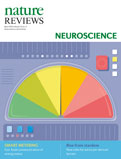|
Advertisement | |||||||||||||||||||||||||||||||||||||||||||||||
| |||||||||||||||||||||||||||||||||||||||||||||||
| TABLE OF CONTENTS | |||||||||||||||||||||||||||||||||||||||||||||||
| April 2018 Volume 19 Number 4 | Advertisement | ||||||||||||||||||||||||||||||||||||||||||||||
| In this issue
|
| |||||||||||||||||||||||||||||||||||||||||||||
| |||||||||||||||||||||||||||||||||||||||||||||||
 | |||||||||||||||||||||||||||||||||||||||||||||||
| Advertisement | |||||||||||||||||||||||||||||||||||||||||||||||
| |||||||||||||||||||||||||||||||||||||||||||||||
| |||||||||||||||||||||||||||||||||||||||||||||||
| Advertisement | |||||||||||||||||||||||||||||||||||||||||||||||
| |||||||||||||||||||||||||||||||||||||||||||||||
| REVIEWS | Top | ||||||||||||||||||||||||||||||||||||||||||||||
Signalling from the periphery to the brain that regulates energy homeostasis Ki-Suk Kim, Randy J. Seeley & Darleen A. Sandoval p185 | doi:10.1038/nrn.2018.8 Coordination between peripheral signals that reflect feeding status and central regulatory mechanisms are crucial for regulating body weight. In this Review, Sandoval and colleagues discuss how and where peripherally derived signals are integrated within the CNS to modulate feeding behaviour. Abstract | Full Text | PDF | |||||||||||||||||||||||||||||||||||||||||||||||
| Effects of adolescent alcohol consumption on the brain and behaviour Linda P. Spear p197 | doi:10.1038/nrn.2018.10 The prevalence of adolescent alcohol use in some countries is high and is associated with various changes in brain function and behaviour. In this Review, Linda Spear examines the contributors to and consequences of alcohol use during adolescence, covering findings in humans and rodent models of this developmental period. Abstract | Full Text | PDF | |||||||||||||||||||||||||||||||||||||||||||||||
| Dendritic structural plasticity and neuropsychiatric disease Marc P. Forrest, Euan Parnell & Peter Penzes p215 | doi:10.1038/nrn.2018.16 The morphology of dendrites and dendritic spines changes with development and as a result of activity-dependent plasticity mechanisms. Penzes and colleagues describe the altered dendritic structural plasticity that is associated with some neuropsychiatric disorders and consider the underlying molecular mechanisms, based on recent genetic discoveries. Abstract | Full Text | PDF | Supplementary information | |||||||||||||||||||||||||||||||||||||||||||||||
| Lactate in the brain: from metabolic end-product to signalling molecule Pierre J. Magistretti & Igor Allaman p235 | doi:10.1038/nrn.2018.19 Much research has shown that lactate produced by astrocytes serves as a neuronal energy substrate. In this Review, Magistretti and Allaman describe this model as well as recent evidence that lactate also modulates neuronal properties, including excitability and plasticity, thus helping to set the 'homeostatic tone' of the nervous system. Abstract | Full Text | PDF | |||||||||||||||||||||||||||||||||||||||||||||||
| Advertisement | |||||||||||||||||||||||||||||||||||||||||||||||
| |||||||||||||||||||||||||||||||||||||||||||||||
| Advertisement | |||||||||||||||||||||||||||||||||||||||||||||||
| |||||||||||||||||||||||||||||||||||||||||||||||
| |||||||||||||||||||||||||||||||||||||||||||||||
| You have been sent this Table of Contents Alert because you have opted in to receive it. You can change or discontinue your e-mail alerts at any time, by modifying your preferences on your nature.com account at: www.nature.com/myaccount For further technical assistance, please contact our registration department For print subscription enquiries, please contact our subscription department For other enquiries, please contact our feedback department Springer Nature | One New York Plaza, Suite 4500 | New York | NY 10004-1562 | USA Springer Nature's worldwide offices: Macmillan Publishers Limited is a company incorporated in England and Wales under company number 785998 and whose registered office is located at The Campus, 4 Crinan Street, London, N1 9XW. © 2018 Macmillan Publishers Limited, part of Springer Nature. All Rights Reserved. |
 |









No comments:
Post a Comment